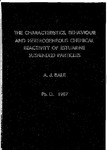THE CHARACTERISTICS. BEHAVIOUR AND HETEROGENEOUS CHEMICAL REACTIVITY OF ESTUARINE SUSPENDED PARTICLES
| dc.contributor.author | Bale, Anthony John | |
| dc.contributor.other | School of Biological and Marine Sciences | en_US |
| dc.date.accessioned | 2013-09-16T08:30:51Z | |
| dc.date.available | 2013-09-16T08:30:51Z | |
| dc.date.issued | 1987 | |
| dc.identifier | NOT AVAILABLE | en_US |
| dc.identifier.uri | http://hdl.handle.net/10026.1/1721 | |
| dc.description.abstract |
A systematic, seasonal study of the distribution, behaviour and characteristics of the suspended and sedimentary particulate material in the macro-tidal Tamar Estuary and its influence on solution chemistry has been undertaken. This work has attempted to characterise the variability in particle properties associated with the major cyclic influences of the semi-diurnal and spring-neap and the seasonal climatic signals and to relate these findings to the distribution and transport of trace metals in estuaries. Characterisation of the particles involved measurements of surface charge using electrophoretic techniques, particle size, settling rates and densities, bulk compositional analysis and visual examination by scanning electron microscopy. At the same time, the internal cycling of particulate material between the sediment and suspended phases through oscillations in tidal energy and the transport of particles associated with the seasonal migration of the mobile estuarine sediment shoal and turbidity maximum material were estimated. Distributions of the dissolved metals, Cu, Zn, Ni and Cd were measured in the estuary over a range of seasonal and tidal conditions. The close co-variance between the degree of soluble metal removal and the location and magnitude of the turbidity maximum indicated that sorption on to particles was a major factor influencing metal distributions in the low salinity region of the estuary. A series of laboratory experiments using radio-isotope s were carried out to examine the factors which influence the partitioning of metals between natural suspended particles and the soluble phase in estuaries. A comprehensive picture of the interactions of salinity, pH and temperature on the partition coefficients for Zn, Cd and Cs was derived. With the aid of a recently developed mathematical model, realistic simulations of the distribution s and fluxes of salt and particles (suspended and sedimentary) in the Tamar Estuary were produced. Corresponding distributions of dissolved zinc were generated by the model using the partition coefficient s derived from the radio-tracer work. The simulated profiles of soluble zinc measured in this way accurately followed the major features of the measured metal distributions as well as closely replicating the absolute values. Manipulations of the model parameters indicated that tidally dominated , up-estuary pumping of metal poor particles was the primary factor controlling the degree of metal removal at the turbidity maximum. | |
| dc.description.sponsorship | Natural Environment Research Council Institute for Marine Environmental Research Prospect Place, The Hoe. Plymouth. U.K. PL1 3DH | en_US |
| dc.language.iso | en | en_US |
| dc.publisher | University of Plymouth | en_US |
| dc.title | THE CHARACTERISTICS. BEHAVIOUR AND HETEROGENEOUS CHEMICAL REACTIVITY OF ESTUARINE SUSPENDED PARTICLES | en_US |
| dc.type | Thesis | |
| plymouth.version | Full version | en_US |
| dc.identifier.doi | http://dx.doi.org/10.24382/1477 | |
| dc.identifier.doi | http://dx.doi.org/10.24382/1477 |
Files in this item
This item appears in the following Collection(s)
-
01 Research Theses Main Collection
Research Theses Main


